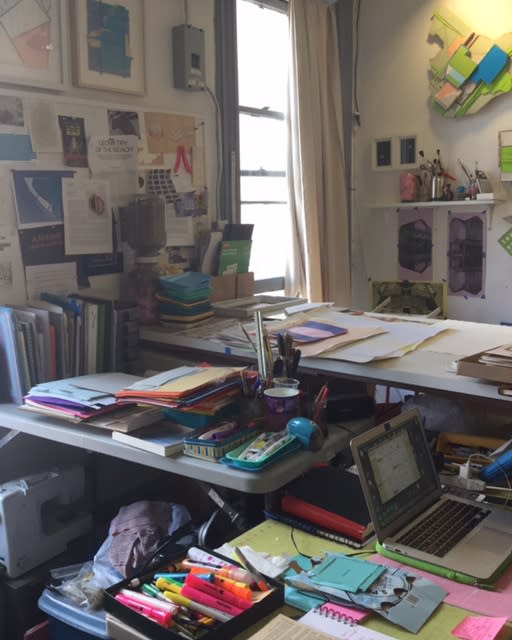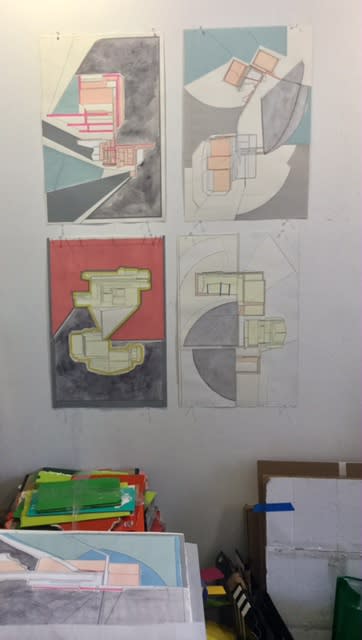Every week, we'll be sitting down with one of our gallery artists to discuss their work, process, inspiration, and stories. This week we're speaking with Ryan Sarah Murphy.

"Forces"
Ryan Sarah Murphy creates reliefs constructed from found discarded cardboard. She removes any identifying branding, text, or pictures, and uses what's left without painting, treating, or otherwise manipulating her materials. Working with a limited palette, she allows the remaining cardboard to serve as a guide, using its energy and unknown history to make her decisions as she assembles the relief. The final collages rest at the intersection of abstract and architectural elements, suggesting a strange terrain seen from an aerial view. The gritty remnants of an urban landscape are revived as bright, bold structures. We visited Murphy's studio in Manhattan to discuss the energy of found materials, working with color you can't create, and using completed works as a road map for new series.

What are your earliest memories related to art?
There wasn't a lot of emphasis on art growing up, but my grandmother was the most influential for me. She was very crafty; she did ceramics and painting. She was also a collector of things, and that's an element that finds its way into my work too. I liked seeing her work and looking at her den all set up with painting supplies and things like that, but she was pretty private about it. In my family we all have a creative thing, but we don't really talk about art so much. We're not really big talkers in general, but we have our artistic outlets as our ways to communicate. I went to Catholic school my whole life too, so art and music was never emphasized at all. So I came to the arts on my own, really. I didn't have any formal education in it before college.
Since art wasn't that big a part of your life before school, how or when did you realize that's what you wanted to do? You went to art school for college, right?
I did, I went to SVA. I've always made things and I've always used art or have turned to making things as my only kind of expression, but it was never a really conscious thing. There was never a moment where I thought, "I am an artist now." I started school at Marymount, and I studied studio art there, and after that first year I realized I needed art school. This is the direction I want to go in. So I transferred to SVA where it was more of an all-encompassing thing, and since then my life has been about art and maintaining a studio practice however I can.

What was the evolution like towards finding your voice and these current bodies of work?
I think initially my work was much more sculpture-based, but I was always using found objects as materials and really looking to the material as the starting point of what I was making. It's always been really process-based and stepping outside of ever having a set plan or idea of what I wanted to make beforehand. It was very much just letting the materials guide the process. But then I was running into space constraints, smaller studios and this and that. I just didn't have enough room for making things that were big or lugging things off the street as much, so things shifted more into works on paper. There was still always a collage element, though, and this construction of images. Then, gradually the more straight-up works on paper became more three-dimensional and climbing off the paper and becoming their own thing. That's when it shifted back towards a more sculptural thing.
Is that how you came to work with found materials, to accommodate for those space constraints? Or was there something in particular you were drawn to?
I think it was a response to sensing the energy in odds and ends, and how color will pop out on certain materials for me. To me, there's nothing worse than blank canvas. I can never really jump in in that way. The kernel of whatever it is I'm supposed to be putting out there, it already exists in this material somewhere and my job is just to be present enough to put that together and let the material become what it's going to become. I'll find things and see there's something there that wants to be reworked and repurposed in a way, and I'll go from there.

Can you put your finger on what it is that catches your eye in particular about materials that you come across that makes you want to take it home with you?
The color is key. One of my limitations is that I don't paint anything on the cardboard, so the color is really the foundation of how the piece gets constructed. I think I started with cardboard because I was doing a lot of works on paper and I wanted something with a little more oompf, and cardboard has a nice density and you can build with it but it's not some big heavy piece of wood. It still has this malleable quality to it. Plus it's so abundant that it's almost calling to be reused. I just find it to be versatile and to me using found color and using found material is a bridge between sculpture and painting and drawing all at once.
Where do you find it, just out and about?
Yeah totally. I'll find it in recycling bins. Initially it started just with things I was buying and saving the boxes or packaging. Like this [San Pellegrino box] right here is a fantastic shade of blue. I have my rules where I'll cut out any text, any sort of branding, things like that, and then what I'm left with will be the material I'll use. I just have this one particular box so, with whatever gets constructed with it, this is the only amount of blue I have and I have to work around that. That allows for me to work through what's being constructed and making those decisions along the way.

Could you talk a bit more about what your process is like for that?
It's just built piece by piece. Something I'm working on now, I have all these leftover book covers because I was using the inside pages of these old books for their paper for another series, so what was left over was all these great covers that I'm now using as foundations for other collages. The material always gets recycled within itself. The paper goes into one piece, the covers go into another series, the bindings will go into something else. So everything kind of filters out in some way. It will start with a shape or a feeling of a shape I have in mind, and I'll start with a color. I'll work on it, leave it on the wall while I work on something else, come back to it, and it'll grow and develop like that. I'm not trying to have some sort of ultimate vision for what it'll become in the end, I'm just letting it be what it wants to be.
How do you go about choosing the colors for each piece?
I'll start with one color, or a little combination, and go from there. I'll respond to each new piece of material that's added to it. Within each piece the palette is limited, I don't go too wild. Working with found color is limited; you can only find certain pinks or certain shades of yellow. Like, I'd love something that's not so much of a bright bubblegum pink, but I haven't found it yet so I need to base my decisions off of what I got. It's not like paint where you can mix up your ideal thing. This is what I have. What does it work with?


Where do you see your work going from here?
The way my studio practice is flowing right now is using completed collage constructions as maps to look to for the next iteration of works. Lately I've been looking at the constructions as drawings, so I'll take elements of them and let that guide works on papers. Those drawings will become new maps when I digitally alter them on the computer, and I'll use those manipulated images as a foundation for these other drawings that are a step further removed from the original construction. They're derivatives of previous maps. Each completed piece is used as a model for the next level.

"Upon"
See more of Ryan Sarah Murphy's work here.